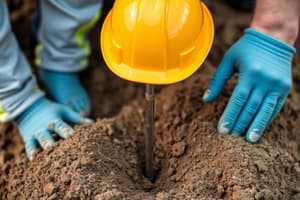Podcast
Questions and Answers
Spread footings have a base that is wider than a typical load-bearing wall ______.
Spread footings have a base that is wider than a typical load-bearing wall ______.
foundation
Raft foundations are spread across the entire area of the building to support heavy ______ from columns and walls.
Raft foundations are spread across the entire area of the building to support heavy ______ from columns and walls.
structural loads
Pile foundations transfer heavy loads from the structure to a hard rock ______ much deeper below the ground level.
Pile foundations transfer heavy loads from the structure to a hard rock ______ much deeper below the ground level.
strata
The use of mat foundations can prevent differential ______ of individual footings.
The use of mat foundations can prevent differential ______ of individual footings.
Spread footings and wall footings are typically used where the bearing soil layer is within ______ from the ground surface.
Spread footings and wall footings are typically used where the bearing soil layer is within ______ from the ground surface.
Soil bearing capacity must be sufficient to support the weight of the ______ over the base area.
Soil bearing capacity must be sufficient to support the weight of the ______ over the base area.
Pile foundations are generally needed in conditions where the surface soil is not suitable for ______ loads.
Pile foundations are generally needed in conditions where the surface soil is not suitable for ______ loads.
Raft foundation is economical when one-half area of the structure is covered with individual ______.
Raft foundation is economical when one-half area of the structure is covered with individual ______.
The most common type of foundation used for building construction is called an ______.
The most common type of foundation used for building construction is called an ______.
When two or more columns are close enough, a ______ footing is constructed that overlaps their isolated footings.
When two or more columns are close enough, a ______ footing is constructed that overlaps their isolated footings.
The shape of an individual footing can be square or ______.
The shape of an individual footing can be square or ______.
The ______ foundation is used when the structure's loads are carried by many columns and tends to be deeper.
The ______ foundation is used when the structure's loads are carried by many columns and tends to be deeper.
A ______ foundation includes systems like pile foundations and drilled shafts or caissons.
A ______ foundation includes systems like pile foundations and drilled shafts or caissons.
The ______ foundation aids in distributing loads across a larger area compared to individual footings.
The ______ foundation aids in distributing loads across a larger area compared to individual footings.
In ______ foundations, the size is calculated based on the load on the column and the safe bearing capacity of the soil.
In ______ foundations, the size is calculated based on the load on the column and the safe bearing capacity of the soil.
An isolated footing is also known as a ______ foundation.
An isolated footing is also known as a ______ foundation.
The ______ transmits loads from columns and walls to the solid ground.
The ______ transmits loads from columns and walls to the solid ground.
If one ______ fails, it can lead to the potential collapse of the entire structure.
If one ______ fails, it can lead to the potential collapse of the entire structure.
Beams carry loads from slabs and also direct loads such as masonry walls and their own ______.
Beams carry loads from slabs and also direct loads such as masonry walls and their own ______.
Shear walls act similarly to very large ______ to withstand horizontal loads.
Shear walls act similarly to very large ______ to withstand horizontal loads.
The loads carried by columns may be ______ or eccentric.
The loads carried by columns may be ______ or eccentric.
Foundations are critical for the load ______ of a building.
Foundations are critical for the load ______ of a building.
The ______ of a structure includes foundations, beams, and columns.
The ______ of a structure includes foundations, beams, and columns.
Elevator shafts are vertical concrete ______ in which elevators are provided to move up and down.
Elevator shafts are vertical concrete ______ in which elevators are provided to move up and down.
Flashcards are hidden until you start studying
Study Notes
Boring Methods
- Auger Boring: A method used for drilling holes in the ground.
- Wash Boring: A method that uses a water jet to remove soil and rock.
- Percussion Boring: A method that uses a hammer to drive a drill bit into the ground.
- Core Boring or Rotary Drilling: A method that uses a rotating drill bit to extract core samples of the ground.
Geophysical Methods
- Used for deep exploration and rapid investigation.
- Common methods include:
- Gravitational methods: Measure variations in gravity to identify underground structures.
- Magnetic methods: Detect variations in the Earth's magnetic field to map geological formations.
- Seismic refraction method: Analyze the travel time of seismic waves to determine the layering and properties of the ground.
- Electrical resistivity method: Measures the resistance of the ground to an electric current to identify different soil types and water content.
- Seismic refraction method and electrical resistivity methods are commonly used in civil engineering.
- These methods are non-intrusive ways of "seeing" into the ground.
- Can be used to identify subsurface hydrological, geological, and contaminant conditions.
Factors Affecting Sample Disturbance
- Area Ratio: The ratio of the borehole cross-sectional area to the sample cross-sectional area.
- Inside Clearance: The space between the borehole wall and the sample.
- Outside Clearance: The space between the sampling tool and the borehole wall.
- Inside Wall Friction: The friction between the sample and the borehole wall.
- Design of Non-Return Valve: The design of the valve that prevents the sample from being lost during retrieval.
- Methods of Applying Forces: The way in which forces are applied during sampling.
- Recovery Ratio: The ratio of the length of the recovered sample to the total length of the sample.
Types of Foundations
- Shallow Foundations:
- Individual Footing or Isolated Footing: Used for a single column and supports loads from structures.
- Combined Footing: Used when two or more columns are close together and their isolated footings overlap.
- Strip Foundation: Runs along the length of a wall, used for supporting walls and bridge piers.
- Raft or Mat Foundation: Spreads across the entire area of a structure to support heavy loads.
- Deep Foundations:
- Pile Foundation: Used to transfer heavy loads deep into the ground to rock strata.
- Drilled Shafts or Caissons: Created by drilling a hole and filling it with concrete to provide support.
Shallow Foundations
- Individual Footing or Isolated Footing:
- Most common type of foundation used for building construction.
- Also known as a pad foundation.
- Shape is typically square or rectangular.
- Size is calculated based on loads and soil bearing capacity.
- Rectangular footings are used when they experience moments due to eccentric loads or horizontal forces.
- Combined Footing:
- Used when two or more columns are close together and their footings overlap.
- Has a rectangular shape.
- Supports loads from structures.
- Spread Footings or Strip Footings and Wall Footings:
- Have a wider base than standard load-bearing wall foundations.
- This wider base spreads the weight from the structure over a larger area, providing better stability.
- Used for individual columns, walls, and bridge piers where the bearing soil layer is within 3 meters (10 feet) of the ground surface.
- Soil must be able to support the weight of the structure.
- Should not be used on soils where there is a possibility of groundwater flow above the bearing layer, which can cause scour or liquefaction (loss of strength).
- Raft or Mat Foundations:
- Spread across the entire area of a building to support heavy structural loads from columns and walls.
- Used when loads from columns and walls are extremely high.
- Prevents differential settlement (uneven sinking) of individual footings.
- Suitable for expansive soils with low bearing capacity that cannot support spread footings or wall footings.
- Economical when half of the structure's area is covered with individual footings and wall footings.
- Should not be used where the groundwater table is above the bearing surface of the soil, as this could lead to scour or liquefaction.
Deep Foundations
- Pile Foundations:
- Used to transfer heavy loads from the structure to hard rock strata deep below the ground level.
- Used when shallow foundations are not suitable due to weak soil conditions near the surface.
- Can also help prevent uplift of the structure due to lateral loads like earthquakes and wind.
- Used when the ground is very weak, and shallow foundations would not be effective.
- Used when there is a possibility of uplift of the structure, as pile foundations can resist these forces.
- Drilled Shafts or Caissons:
- Created by drilling a hole in the ground and filling it with concrete.
- The concrete shaft provides support for the structure.
- Used when the groundwater table is high, and the soil is unstable.
- Used when there is a possibility of uplift of the structure.
Other Important Structural Elements
- Beams: Horizontal members that carry loads from slabs and masonry walls.
- Columns: Vertical members carrying loads from beams and upper columns.
- Foundation: The load transmitting member, transferring loads from columns and walls to the ground.
- Shear Walls: Large columns that resist horizontal loads like wind and earthquakes (work in one direction only).
- Elevator Shaft: Vertical concrete boxes for elevators.
Studying That Suits You
Use AI to generate personalized quizzes and flashcards to suit your learning preferences.





